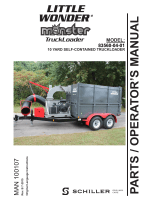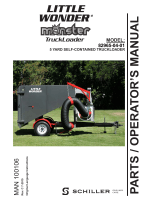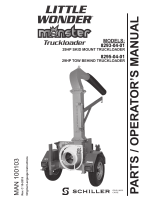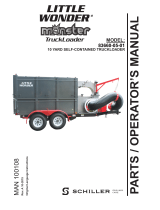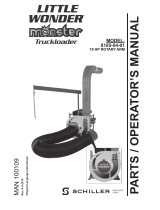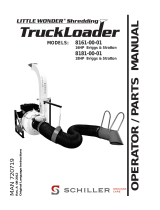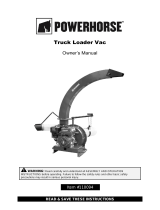Page is loading ...

PARTS / OPERATOR’S MANUAL
MAN 100129
Rev. A 6-2017
Original Language Instructions
MODEL:
8143-06-01
14 HP Kohler

CALIFORNIA
Proposition 65 Warning
Diesel engine exhaust and some
of its constituents are known to the
State of California to cause cancer,
birth defects and other reproductive
harm.
WARNING
The engine exhaust from this product
contains chemicals known to the State
of California to cause cancer, birth
defects or other reproductive harm.
CALIFORNIA
Proposition 65 Warning
Battery posts, terminals, wiring
insulation, and related accessories
contain lead and lead compounds,
chemicals known to the State of
California to cause cancer and birth
defects or other reproductive harm.
WASH HANDS AFTER HANDLING.

1
TRUCKLOADER
IMPORTANT MESSAGE
On behalf of everyone at Little Wonder, we would like to thank you for your purchase of a Little Wonder TruckLoader.
This professional truckloader was designed to the highest standards to ensure many hours of uninterrupted service.
This machine comes with an Operators / Parts Manual. The useful life and good service you receive from this machine
depends to a large extent on how well you read and understand this manual. Treat your machine properly, lubricate and
adjust it as instructed, and it will give you many years of reliable service.
Your safe use of this Little Wonder product is one of our prime design objectives. Many safety features are built in, but we also
rely on your good sense and care to achieve accident-free operation. For best protection, study the manual thoroughly. Learn
the proper operation of all controls. Observe all safety precautions. Follow all instructions and warnings. Do not remove or
defeat any safety features. Make sure those who operate this machine are as well informed and careful in its use as you are.
See a Little Wonder dealer for any service or parts needed. Little Wonder service ensures that you continue to receive
the best results possible from Little Wonder products. You can trust Little Wonder replacement parts because they are
manufactured with the same high precision and quality as the original parts.
Little Wonder designs and builds its equipment to serve many years in a safe and productive manner. For longest life,
use this machine only as directed in the manuals, keep it in good repair and follow safety warnings and instructions. You'll
always be glad you did.
Little Wonder
1028 Street Rd.
Southampton, PA 18966
TABLE OF CONTENTS FIGURES PAGE
SAFETY ......................................................................................................................................................... 2-6
LABELS ............................................................................................................................................................ 7
SET-UP INSTRUCTIONS ............................................................................................................................8-11
CONTROLS ....................................................................................................................................................12
OPERATION ..............................................................................................................................................13-14
MAINTENANCE / STORAGE ....................................................................................................................15-16
SPECIFICATIONS .......................................................................................................................................... 17
PARTS SECTION ........................................................................................................................................... 18
WARRANTY ............................................................................................................................... BACK COVER

2
TRUCKLOADER
MODEL NUMBER: This number appears on
sales literature, technical manuals and price lists.
SERIAL NUMBER: This number appears only
on your unit. It contains the model number
followed consecutively by the serial number.
Use this number when ordering parts or seeking
warranty information.
Schiller Grounds Care, Inc.
1028 Street Road
Southampton, PA 18966 U.S.A
Phone: 215-357-5110
Fax: 215-357-8045
MODEL NUMBER
SERIA
L NUMBER
SAFETY
NOTICE !!!
Unauthorized modications may present extreme
safety hazards to operators and bystanders and
could also result in product damage.
Little Wonder strongly warns against, rejects and
disclaims any modications, add-on accessories or
product alterations that are not designed, developed,
tested and approved by Little Wonder Engineering
Department. Any Little Wonder product that is altered,
modied or changed in any manner not specically
authorized after original manufacture–including the
addition of “aftermarket” accessories or component
parts not specically approved by Little Wonder–will
result in the Little Wonder warranty being voided.
Any and all liability for personal injury and/or property
damage caused by any unauthorized modications,
add-on accessories or products not approved by
Little Wonder will be considered the responsibility
of the individual(s) or company designing and/or
making such changes. Little Wonder will vigorously
pursue full indemnication and costs from any party
responsible for such unauthorized post-manufacture
modications and/or accessories should personal
injury and/or property damage result.
This symbol means:
ATTENTION!
BECOME ALERT!
Your safety and the safety of others is involved.
Signal word denitions:
The signal words below are used to identify levels
of hazard seriousness. These words appear in this
manual and on the safety labels attached to Little
Wonder machines. For your safety and the safety
of others, read and follow the information given with
these signal words and/or the symbol shown above.
DANGER indicates an imminently hazardous
situation which, if not avoided, WILL result in death
or serious injury.
WARNING indicates a potentially hazardous
situation which, if not avoided, COULD result in
death or serious injury.
CAUTION indicates a potentially hazardous situation
which, if not avoided, MAY result in minor or moderate
injury. It may also be used to alert against unsafe
practices or property damage.
CAUTION used without the safety alert symbol
indicates a potentially hazardous situation which, if
not avoided, MAY result in property damage

3
TRUCKLOADER
SAFETY
PREPARING FOR SAFE OPERATION
Operator preparation and training
Read the Operation & Safety
Manual
- If an operator or mechanic
cannot read English, it is
the owner's responsibility
to explain this material to
them. If any portion of this
material is unclear, contact
your factory representative for clarication.
- Decals regarding safety and/or unit operations
have been placed on parts of the machine.
Adhere to the warnings and instructions depicted
in these decals. Replace any missing or
damaged labels.
- Become familiar with the safe operation of the
equipment, operator controls and safety signs.
Know how to stop the engine and attachments
quickly in an emergency. Do not operate or allow
another person to operate this machine if there
are any questions about safety.
- All operators and mechanics should be trained.
The owner is responsible for training the users.
Never attempt to use a machine that is damaged
or has unauthorized modications.
- Wear appropriate clothing, including gloves.
Do not operate barefoot or when wearing open
sandals. Long hair, loose clothing or jewelry may
get tangled in moving parts.
- Wear hearing protection.
- Wear safety glasses.
- Wear a dust mask to avoid breathing dust.
- Never allow underage children, unskilled
or improperly trained people to operate this
equipment. Local regulations can restrict the age
of the operator. Never allow to ride, sit or stand
on machine.
- Keep warning labels and this operator's manual
legible and intact. Replacement labels and
manuals are available from the factory.
- Do not operate machine while under the
inuence of drugs or alcohol.
- The owner/user can prevent and is responsible
for accidents or injuries occurring to themselves,
other people or property.
Site preparation and circumstances
- If TruckLoader is mounted on a trailer, make
sure that the driver of the towing vehicle has the
operator of the TruckLoader in full view at all
times.
- Check the area to be cleared of objects such
as rocks, toys, wire or other debris that may be
picked up or thrown by the machine.
- Be sure the area is clear of pets and people,
especially young children. Never assume they
will remain where you last saw them. Stop the
machine if any enter the area.
- Use machine only in daylight or in good articial
light.
- Evaluate the terrain to determine how to safely
perform the job. Only use accessories and
attachments approved by the manufacturer.
Machine preparation
- Do not tamper with or defeat safety devices.
Keep guards and shields in proper working
condition. They are for your protection.
- Keep all fasteners such as nuts, bolts and pins
well secured.
- Verify that machine and attachments, if any, are
in good operating condition.
- Do not start machine until ready to use.
- Do not stand in front or behind machine.
Operator MUST stay on the side of the machine.

4
TRUCKLOADER
SAFETY
Interrupting operation
- Before leaving the operator's position:
- Move throttle to the SLOW position.
- Shut off the engine by moving the switch to the
OFF position.
- Move the throttle to the SLOW position, turn key
to the OFF position and wait till all moving parts
have come to a complete stop.
- before refueling;
- Move the throttle to the SLOW position, move
switch to the OFF position, wait till all moving
parts have come to a complete stop and
disconnect the spark plug wire(s) or remove the
key:
- before clearing blockages or unclogging chute;
- before checking, cleaning or working on the
machine;
- after striking a foreign object. Inspect the
machine for damage and make repairs before
restarting;
- if the machine begins to vibrate abnormally:
shut off machine immediately. Inspect and
make repairs as needed before restarting;
- except for repairs or adjustments as specically
noted, such as for carburetor adjustment,
where the engine must be running. Keep
hands and feet clear of moving parts in these
circumstances.
- Allow the fan to come to a complete stop when
stopping operation to clear blockages, unclog,
inspect the machine, do maintenance or repair.
- Reduce the throttle setting to SLOW during
engine shut-down. Move switch to the OFF
position.
OPERATION SAFETY
In general
- Use extra care when loading or unloading the
truckloader onto a trailer or truck.
- Slow down and use caution when making turns
and crossing roads and sidewalks.
- Do not run the engine in an enclosed area where
dangerous carbon monoxide fumes can collect.
- While operating the machine, maintain a safe
operating position, secure footing, and good
balance at all times.
- Before operating, install intake hose and
discharge chute.
- Keep a safe distance between two or more
operators when working together simultaneously.
- Keep clear of the discharge opening at all times.
Never direct the discharge toward a bystander.
Stop operation if someone approaches.
- Never leave a machine unattended. Always turn
off engine, set throttle to SLOW, switch is in OFF
position, and fan has come to a complete stop
before leaving machine.
- Maintain machine according to manufacturer's
schedule and instructions for maximum safety
and best results.
- Never look into the hose or discharge chute while
machine is running. Never operate machine
without intake hose attached properly.
Starting
- Start only according to instructions in this manual
or on the machine.
- When starting the engine, make sure hands and
feet are clear of the intake hose.
- Do not start the machine while standing in front
of the discharge chute or with the chute directed
at someone.
- Do not change engine governor settings or
overspeed the engine. Operating the engine
at excessive speed can increase the hazard of
personal injury.

5
TRUCKLOADER
SAFETY
MAINTENANCE SAFETY
In general
- Maintain machine according to manufacturer's
schedule and instructions for maximum safety
and best results.
- Rotating Impeller: Do not attempt to remove
materials from intake or discharge when
truckloader is running or impeller is still rotating.
- Never allow untrained personnel to service
machine.
- Adjust or repair only after the engine has been
stopped and the fan has stopped rotating.
- Inspect truckloader components regularly. If
worn, damaged or deteriorated, they may expose
moving parts or allow objects to be thrown.
- Replace parts if worn, damaged or faulty. Have
repairs made by a qualied Little Wonder dealer
or repairman. For best results, always replace
with parts recommended by the manufacturer(s).
- Turn off engine, set throttle to SLOW position,
move switch to OFF position. Disconnect remove
spark plug wire(s) before making any repairs.
- Do not dismantle the machine without releasing
or restraining forces which may cause parts to
move suddenly.
- Provide adequate support, e.g. jack stands for
lifted machine or parts if working beneath.
- Do not put hands or feet near or under rotating
parts.
- Clean up spilled oil or fuel thoroughly.
- Replace faulty mufers.
- To reduce re hazards, keep the engine, mufer,
battery compartment and fuel storage area free
of grass, leaves, debris buildup or grease.
Rotating Impeller
- Don't attempt to remove
materials from intake or
discharge when unit is running
or impeller is rotating.
- Fan coasts after the engine is
turned off.
- Only replace impeller. Never straighten or weld
them.
- Keep other persons away from impeller.
- Caution should be used when clearing debris
from inside the housing. Gloves should be worn
as sharp edges on the impeller or in the debris
may be present.
Fuel
- Gasoline is ammable;
gasoline vapors are
explosive. Use extra care
when handling.
- Store only in containers
specically designed for fuel.
- When refueling or checking fuel level:
- Stop the engine and allow to cool;
- Do not smoke;
- Refuel outdoors only;
- Use a funnel;
- Do not overll;
- If fuel is spilled, do not attempt to start the
engine until the spill is cleaned up and vapors
have cleared.
Sparks from static electricity can start res or cause
explosions. Flowing fuel can generate static
electricity. To prevent static electricity sparks:
- Keep containers electrically grounded. Do not ll
containers in a vehicle or on a truck or trailer bed
with a plastic liner. Fill containers on the ground
away from the vehicle.
- When practical, remove gas powered equipment
from the truck or trailer and refuel it on the
ground. If equipment must be refueled on the
truck or trailer, refuel from a portable container
rather than a dispenser nozzle.
- Keep the dispenser nozzle in contact with the rim
of the fuel tank or container opening until fueling
is complete. Do not use a nozzle lock-open
device.
- Replace caps on fuel cans and tanks securely.
- If fuel is spilled on clothing change it immediately.
WARNING
WARNING

6
TRUCKLOADER
SAFETY
ENGINE
- Don't run engine if there is an accumulation of
debris around the mufer and cooling ns.
- Don’t run engine while electrical system causes
spark outside the cylinder.
- Don't touch hot mufers, cylinders or cooling ns
as contact may cause serious burns.
OIL
- EQUIPMENT IS SHIPPED WITHOUT OIL! Refer
to engine manufacturers instruction manual for
instructions on lling the oil.
STORAGE AND TRANSPORTATION
- Stop the engine and allow to cool before storing.
- Drain the fuel tank outdoors only.
- Store fuel in an approved container in a cool, dry
place.
- Keep the machine and fuel containers in a locked
storage place to prevent tampering and to keep
children from playing with them.
- Do not store the machine or fuel container near
heating appliances with an open ame such as a
water heater or an appliance with a pilot light.
- Keep gasoline storage area free of grass, leaves
and excessive grease to reduce re hazard.
- Clean grass and debris from cutting units, drives,
mufers and engine to help prevent res.
- When not in use store indoors in a sheltered
area (a dry place) where it is not accessible
to children. DO NOT store in a house. Keep
throttle in SLOW position and switch in the OFF
position.

7
TRUCKLOADER
LABELS
P/N MP100154
P/N MP100153

8
TRUCKLOADER
SET UP INSTRUCTIONS
6
LITTLE WONDER
TRUCKLOADER
SET-UP
DEBRIS RECEPTACLE
The Shredding Truckloader is intended to be used
in conjunction with a truck or trailer mounted debris
receptacle to load landscape debris for removal from a
work site to storage, dump or processing site. These
receptacles or debris bodies or boxes are provided
by the user and are the responsibility of the user.
Following are some considerations to keep in mind
when designing / building, or buying a debris receptacle
on a vehicle.
1. It must be road worthy.
2. It must be constructed sturdily enough to contain the
high velocity and force of entering debris to prevent
injury to bystanders and damage to property.
3. Sufcient screen area must be provided to allow
the air produced by the truckloader to escape while
containing the lighter debris. A bigger screen area
reduces the speed of the air through the screen and
helps reduce the amount of debris that will be held
to the screen. The screen area should be in the
last area to be ll so it stays clean. If the air cannot
escape, the truckloader will not be able to generate a
vacuum to pick up debris.
4. It should prevent the debris from blowing out during
transport to an unloading site.
5. Unloading: Provision must be made for unloading.
ASSEMBLY AND SET-UP
1. Remove unit from crate.
2. Your Little Wonder Truckloader can be mounted in
(4) four ways. The frame mounting will be covered
below. Refer to the instruction sheet supplied
with each kit for Swing Away, Tailgate, or Hitch
mounting.
3. Fill the engine with oil. Fill the fuel tank with clean
fresh gasoline.
4. Assemble the discharge chute. Slide ange clamp
plate over discharge chute. Position the discharge
ange over the fan housing ange. Position the
ange clamp plate over the fan housing studs and
secure with (2) two 3/8-16 nylon insert ange nuts
and 2 (two) locking knobs. Back the nuts off from
tight just enough that the
chute may be turned for
positioning. Lock the chute in the desired position
by tightening the knobs.
UNIT MOUNTING AND MOUNTING KITS.
Most Truckloader installations are customized and
somewhat unique. It is the responsibility of the
installer to ensure the installation is sufcient to carry
the truckloader or truckloader mounting kit.
Your Little Wonder 14HP Truckloader can be
mounted in four different ways. Brief instructions for
each are listed below. Refer to the specic mounting
kit for detailed instructions.
MOUNT SHREDDING TRUCKLOADER FRAME
1. Mount the Shredding truckloader frame to the
frame or swing away, and secure frame with (6)
six 3/8" hex head bolts (Grade 5 or better), 3/8"
at washers, and 3'8" lock nuts.
5. Assemble the boom assembly in the receiver tube
on top of the fan housing. Connect the hose to the
inlet ange. Insert the adaptor, turn to lock and
secure in place with the locking knobs.
6. Read the Operator's manual before operating the
machine.
DEBRIS RECEPTACLE
The Truckloader is intended to be used
in conjunction with a truck or trailer mounted debris
receptacle to load landscape debris for removal from
a work site to storage, dump or processing site. These
receptacles or debris bodies or boxes are provided
by the user and are the responsibility of the user.
Following are some considerations to keep in
mind when designing / building, or buying a debris
receptacle on a vehicle.
1. It must be road worthy.
2. It must be constructed sturdily enough to contain the
high velocity and force of entering debris to prevent
injury to bystanders and damage to property.
3. Sufcient screen area must be provided to allow
the air produced by the truckloader to escape while
containing the lighter debris. A bigger screen area
reduces the speed of the air through the screen and
helps reduce the amount of debris that will be held
to the screen. The screen area should be in the last
area to be lled so it stays clean. If the air cannot
escape, the truckloader will not be able to generate
a vacuum to pick up debris.
4. It should prevent the debris from blowing out during
transport to an unloading site.
5. Unloading: Provision must be made for unloading.
ASSEMBLY AND SET-UP
1. Remove unit from crate.
2. Your Little Wonder Truckloader can be mounted in (4)
four ways. The frame mounting will be covered below.
Refer to the instruction sheet supplied with each kit for
Swing Away, Tailgate, or Hitch mounting.
3. Fill the engine with oil. Fill the fuel tank with clean fresh
gasoline.
4. Assemble the discharge chute. Slide ange clamp
plate over discharge chute. Position the discharge
ange over the fan housing ange. Position the ange
clamp plate over the fan housing studs and secure
with (2) two 3/8-16 nylon insert ange nuts and 2 (two)
locking knobs. Back the nuts off from tight just enough
that the chute may be turned for positioning. Lock the
chute in the desired position by tightening the knobs.
5. Assemble the boom assembly in the receiver tube on
top of the fan housing. Connect the hose to the inlet
ange. Insert the adaptor, turn to lock and secure in
place with the locking knobs.
6. Read the Operator’s manual before operating the
machine.
UNIT MOUNTING AND MOUNTING KITS.
Most Truckloader installations are customized and
somewhat unique. It is the responsibility of the installer to
ensure the installation is sufcient to carry the truckloader
or truckloader mounting kit.
Your Little Wonder 14HP Truckloader can be mounted in
four different ways. Brief instructions for each are listed
below. Refer to the specic mounting kit for detailed
instructions.
MOUNT SHREDDING TRUCKLOADER
FRAME
1. Mount the Shredding truckloader frame to the frame
or swing away, and secure frame with (6) six 3/8” hex
head bolts (Grade 5 or better), 3/8” at washers, and
3/8” lock nuts.

9
TRUCKLOADER
SET UP INSTRUCTIONS
Skid Mount
Application: Trailer mount or permanent truck mount:
To use the truckloader as a skid mount, supply a
suitable surface for the unit to sit on and secure
with 3/8” fasteners. If the surface is a wood deck
of 2” nominal thickness (1-1/2” actual thickness),
lag screws or bolts and lock nuts may be used.
Use Grade 5 or better bolts. Nylon insert locknuts
are recommended. If wood decking is less than 2”
nominal thickness, or if steel brackets are used, 3/8”
bolts and nylon insert locknuts are recommended.
Direct the discharge chute to the debris receptacle
area.
Hitch Mount (Kit 720060)
Vehicle Requirement: Vehicle with 2” square Class
III or Class IV hitch receiver.
Application: Inexpensive mount on either a xed
or tilted bed truck. Must be removed to tilt bed or
unload.
Install the hitch bar in the channel underneath the
truckloader unit. Secure the hitch bar from pulling
out with the hitch pin and hairpin cotter provided.
Sandwich the hitch bar between the unit and the
clamp plate: Secure the clamp plate with six (6)
3/8-16X1 bolts and six (6) 3/8-16 nylon insert ange
nuts.
To mount the unit on a truck get a helper and pick up
the unit. Use proper lifting technique. Slide the hitch
bar into the vehicle’s hitch receiver. Secure with the
hitch pin and hairpin cotter. Attach the safety chains
to the vehicle.
To remove the unit, remove the hose/boom
assembly, disconnect the safety chains and hitch
pin. With a helper, lift and slide the unit out of the
vehicle hitch receiver and set down.
Tailgate Mount (Kit 720061)
Vehicle Requirement: A suitable heavy duty tailgate
like those used on dump bodies or a similar
structure. A pickup tailgate will not handle this
mount.
Application: Fixed or tilt bed. Must be removed to tilt
or unload. Keeps hitch receiver free so a trailer may
be pulled.
Install tailgate mount on the tailgate of your truck.
Adjust the clamps to grip the tail gate securely when
the lever handle is pulled down and locked. If the
adjusting nuts do not provide sufcient travel, the
clamp pads may be moved to a different set of holes
to get a secure t.
Remove the mount from the tailgate and install the
hitch bar in the channel underneath the truckloader
unit. Secure the hitch bar from pulling out with the
hitch pin and hairpin cotter provided. Sandwich the
hitch bar between the unit and the clamp plate.
Secure the clamp plate with six (6) 3/8-16x1 bolts
and six (6) 3/8-16 nylon insert ange nuts.
To mount the unit on a truck get a helper and pick up
the assembly and lift it over the tailgate. Use proper
lifting technique. Pull the clamp levers down and
secure them in place with the locks.
To remove the unit, remove the hose/boom
assembly, unlock the clamp levers and open the
clamps. With a helper, lift the unit over the vehicle
tail gate and set down. Use proper lifting technique.

10
TRUCKLOADER
SET UP INSTRUCTIONS
Swing-Away (Kit 720062)
Vehicle Requirement: Vehicle with 2” square Class III
or Class IV hitch receiver.
Application: One man unloading of tilt bed vehicles
with beds up to 96” wide.
With a helper, lift the swing-away frame and slide the
hitch bar into the vehicle receiver. Use proper lifting
technique. Secure with the hitch pin and the hairpin
cotter. Attach the safety chain to the vehicle. Lift the
truckloader unit and place it on top of the swing-away
frame. Secure it to the frame with six (6) 3/8-16x1 bolts
and six (6) 3/8-16 nylon insert ange nuts.
To use the swing-away feature, pull the hitch pin on
the right side and the lynch pin holding the frame
together on the left side. Pull the swing-away frame
open. The swing-away may be locked in the 90 degree
or 180 degree positions with the hitch pin.
DO NOT transport with the swing-away in either
open position.
Damage to the swing-away or vehicle may result.
Close the swing-away and secure with lynch pin
before transporting.
The swing-away may be used to vacuum debris in the
90 degree position.
The 180 degree position is for dumping the load of
debris collected in the truck box. Before using the
swing-away, conduct a trial run to be sure there is
sufcient clearance between the truckloader and the
truck body.
OTHER KITS AND ACCESSORIES AVAILABLE FOR
YOUR TRUCKLOADER:
720025- 18” HOUSING EXTENSION KIT
720027- 6’ DISCHARGE CHUTE EXTENSION KIT
720070- CHUTE DEFLECTOR KIT
INSTALL DISCHARGE CHUTE TO POWER UNIT
1. Slide the ange clamp plate over the discharge
chute deector down to the ange.
2. Orient the discharge chute with liner so its ange is
facing the top of the Shredding truckloader housing,
and slide the ange clamp plate over the four
housing ange studs.
3. Direct discharge into The debris receptacle, and
afx it with (2) two knobs, (2) two anged nylon
insert nuts as shown below.
CHANGE DISCHARGE CHUTE DIRECTION
1. Loosen knobs and nuts.
2. Swivel discharge chute to desired direction.
3. Afx chute by retightening knobs and nuts.
4. Additional tools are not needed.
WARNING

HOSE
HOSE FLANGE
BRIDGE CLAMP
BRIDGE CLAMP
HOSE BANDS
11
TRUCKLOADER
SET UP INSTRUCTIONS
INSTALL HOSE AND BOOM ARM TO
HOUSING (SEE FIGURE 1 FOR ASSY)
1. Remove hose from box and stretch it.
2. Hold the hose, and stretch each end as far as
possible to open internal diameter.
3. Slide bridge clamp over each end of hose.
4. Insert hose ange in one end of hose and tighten
bridge clamp.
5. Place hose bands over hose, near ange end.
6. Get boom arm assembly and attach chains to
hose bands with bolts and nuts.
7. Place boom arm pivot shaft into housing tube.
8. Install knobs onto hose ange. Leave knobs
loose.
9. Push hose ange studs into front plate notches
and turn to lock. Tighten knobs to secure into
position.
10. Install hose nozzle/handle assembly, onto other
end of hose. Orientate handle to desired position
and tighten bridge clamp.

12
TRUCKLOADER
CONTROLS
SWITCH (A)
Move to the “OFF” position to stop the engine.
Move to the “ON” position before starting engine.
THROTTLE (B)
Controls engine speed and the amount of air
being blown.
CHOKE (C)
Move to the “CHOKE” position to apply the
choke. Move to the “RUN” position to remove the
choke.
FUEL SHUT OFF (A)
Move to the “OFF” position to shut off the fuel
whenever transporting the machine by trailer or
truck during storage. Move to the “ON” position
before starting the engine.
HOSE ATTACHMENT
Slide the hose adaptor into the slots on the inlet
tube, twist it to lock the studs into the slots and
tighten the locking knobs to secure in place.
BOOM ASSEMBLY
The hose boom assembly supports the hose
while allowing it to move horizontally.
DISCHARGE CHUTE
The discharge chute can be turned to point in the
desired direction. to turn the chute, loosen the
knobs and turn the chute to the desired direction.
Tighten the knobs to secure.
B
C
A

13
TRUCKLOADER
BEFORE STARTING THE ENGINE
1. Be familiar with the controls, how each functions,
and what each operates.
2. Check engine oil level. Add oil if necessary,
following the engine manufacturer’s
recommendations. Refer to engine manual
included with literature packet.
3. Check the air cleaner for dirty, loose, or
damaged parts. Clean or replace if necessary.
4. Check the air intake and cooling area for dirt or
debris and clean as necessary.
Gasoline is extremely ammable and highly
explosive under certain conditions. BE SURE to
install fuel cap after refueling.
Fill fuel tank with good quality, clean, unleaded
regular gasoline to the level recommended by the
engine manufacturer.
TO CHECK OR ADD FUEL:
- Use a funnel to avoid spilling.
- Do it outdoors.
- Do not smoke.
- Stop the engine; allow to cool.
- Do not overll.
- Clean up spilled fuel.
STARTING THE ENGINE
1. Turn the engine and fuel lever on and move the
throttle to the half open position.
2. Move the choke to the ON position for cold
starts. For warm starts attempt to start without
the choke rst to avoid ooding. If the engine
does not start then use the choke.
3. Pull the recoil starter handle rmly to start the
engine.
4. When the engine starts, gradually back off the
choke until the engine runs with no choke.
OPERATION
INTENDED USE
This unit is intended for vacuuming leaves, clippings and other similar sized organic material from the ground
into a truck or trailer. Large sized or long stringy material will tend to clog.
Vacuuming sand, rocks, and hard litter will shorten the life of this machine and may damage the machine or
parts of it.
PRE-OPERATION CHECK LIST
(OPERATOR’S RESPONSIBILITY)
- Review and follow all safety rules and safety
decal instructions.
- Check that all safety decals are installed and in
good condition. Replace if damaged.
- Check to make sure all shields and guards are
properly installed and in good condition.
- Make sure the discharge chute and hose are
installed.
- Check the hose, discharge chute, liners, and
housing for wear. Do not operate if these parts
are worn through. Replace or repair before
operating.
- Check that all hardware is properly installed and
secured.
- Check to be sure engine is free of dirt and
debris. Pay particular attention to the cooling
ns, governor parts and mufer. Clean air intake
screen. Check air cleaner; service if necessary.
- Clean area around the oil ll dipstick. Remove
dipstick and check to be sure oil is in operating
range (between marks on dipstick). Add oil if
necessary but Do Not Overll. See engine
manual for oil specications. Install dipstick
assembly rmly until cap bottoms out on tube.
Dipstick assembly must always be secured into
ll tube when engine is running.
- Inspect material to be vacuumed and remove
stones, branches or other hard objects that
might damage the machine or cause it to clog.

14
TRUCKLOADER
OPERATING
This machine has been designed for two methods of
vacuuming debris:
- With the handle of the Intake Nozzle in the
operator’s hands, move the nozzle back and forth
in a sweeping motion over the debris
- Rotate Intake Nozzle to lay sideways on the
ground. By placing the Nozzle in this position,
debris can be raked into the nozzle by an
operator.
While large amounts of debris can be vacuumed
quickly with this machine, caution must be taken to
avoid blocking the airow into the Nozzle.
STOPPING THE ENGINE
When operation is complete or the unit needs to be
checked or a clog needs to be cleared:
1. Move the throttle to SLOW.
2. Set the engine and fuel lever to the OFF position.
3. Note: Impeller will continue to rotate for several
seconds after engine is stopped.
EXCESSIVE VIBRATION
Shut off the engine immediately if abnormal/excessive
vibration occurs. Remove spark plug wire. Find
the cause of vibration and repair it. Some possible
causes for excessive vibration are:
- Damaged impeller
- Loose impeller bolt
- Loose impeller key
- Lodged objects
CLOGS
To prevent clogs, do not overfeed, especially with
heavy wet material.
Pay attention to how full the debris receptacle is.
Overlled debris receptacles cause material to back
up and get tightly packed in the discharge cute.
REMOVING CLOGS
If a decrease in suction is experienced, there may be
a debris blockage in the hose. Often a clogged hose
can be cleared by stretching the hose out straight with
the engine running. If the hose does not clear, you
will need to remove the hose. Before removing the
hose or attempting to clear a clog manually:
- STOP the engine. Put the engine switch in the
OFF position.
- Wait for the impeller to come to a complete stop.
- Disconnect the spark plug wires so impeller
movement cannot accidentally start the engine.
Removing Clogs ( continued)
CAUTION SHOULD BE USED WHEN CLEARING
DEBRIS FROM INSIDE THE HOUSING. GLOVES
SHOULD BE WORN AS SHARP EDGES ON THE
IMPELLER OR IN THE DEBRIS MAY BE PRESENT.
Remove the Hose Assembly from the Inlet Flange
Assembly. With this removed, open the Inlet Flapper
and remove any debris that is clogging the housing.
Remove the Discharge Chute from the Transition
Discharge tube’s ange. With the Chute removed,
inspect the Transition Discharge part of the housing
and remove any debris clogging this area.
Reassemble removed parts, reconnect the spark plug
wire and resume operation.
NEVER TRANSPORT MACHINE
WHILE IT IS RUNNING
TRANSPORT
1. Shut off the engine and fuel valve.
2. Disconnect the hose from the power unit.
3. Remove the boom assembly from the frame (it
can stay with the hose.)
4. Remove the discharge chute.
5. Transport the hose/boom assembly and discharge
chute secured in the truck or trailer.
6. Do not exceed 30 mph. High speeds together with
rough roads can cause damage to the unit
OPERATION

15
TRUCKLOADER
MAINTENANCE / STORAGE
DAILY MAINTENANCE
- Inspect the intake hose connector to make sure it
is securely fastened to the intake cover assembly
- Inspect the hose, chute, chute liner, and housing
liner for wear. Replace worn parts or have them
repaired.
- Tighten any loose fasteners.
ENGINE OIL
- Check the oil level daily.
- Change after the rst day of operation and then
according to the engine manual.
- See the engine manual for oil specications and
checking procedure.
ENGINE AIR CLEANER
- Check and clean according to the engine
manuals.
- Little Wonder recommends daily inspection and
cleaning due to the extreme environment of
debris handling.
CLEANING
Keep the area around the mufer and engine
recoil cover /cooling air intake free of debris
accumulation to prevent res and keep the engine
from overheating. These areas need to be monitored
throughout the work day and may need to be cleaned
several times daily depending on circumstances.
HOUSING LINER REPLACEMENT
- Before replacing liner stop engine.
- Put engine switch in OFF position.
- Remove spark plug wire so fan movement
cannot inadvertently start engine.
- Remove hose from blower inlet.
- Remove nuts securing blower inlet assembly and
open blower inlet assembly.
- Remove liner retainer.
- Remove the old liner.
- Install the new liner with the thick rubber side
towards the fan. Use new bolts and washers.
Start at one end and work around the housing
leaving the fasteners loose until all the fasteners
have been installed. Then tighten the bolts until
the washer is slightly drawn into the rubber. Do
not over tighten
- Reinstall liner retainer. See parts list for locations
of carriage bolts.
CHUTE LINER REPLACEMENT
- Before replacing liner stop engine.
- Put engine switch in OFF position.
- Remove spark plug wire so fan movement
cannot inadvertently start engine.
- Remove chute from blower housing.
- Remove rubber plugs from access holes on the
bottom of the chute.
- Remove nuts, washers, bolts then remove old
liner.
- Feed the new liner into the chute. Using new
bolts and new washers on the inside, and new
washer and new nuts on the outside, install new
fasteners working in from each end. Leave the
bolts loose until all fasteners are installed. Then
tighten the nuts and bolts, working from the
inside out.
- Reinstall the rubber plugs.
- Reinstall the chute on the machine.

16
TRUCKLOADER
MAINTENANCE / STORAGE
STORAGE
To prevent possible explosion or ignition of vaporized
fuel, do not store equipment with fuel in tank or
carburetor in an enclosure or enclosed area with an
open ame (for example, a furnace or water heater
pilot light.)
Before the equipment is put into storage for any
period exceeding 30 days, the following steps
should be completed.
1. Drain all fuel from the fuel tank and the fuel lines.
Drained fuel may only be stored for 30 days. If
a stabilizer is chosen, follow the manufacturer's
recommendation by adding the correct amount of
additive for the amount of fuel to be stored. Fill
the tank with this clean, fresh gasoline and run the
engine for 2 to 3 minutes to get the stabilized fuel
into the carburetor.
2. Start the engine and run until all the fuel is used
from the carburetor oat bowl and the engine
stops.
3. While the engine is still warm, drain the crankcase
oil and replace with the proper weight oil
corresponding to the season the equipment will be
used next.
4. Remove the spark plug and squirt a small amount
of engine oil into the cylinder. Reinstall the plugs
and ground spark plug leads- DO NOT connect
the leads to the plugs. Crank the engine two or
three revolutions.
5. Store the unit and all of it's components in a
clean, dry, well ventilated, non-child accessible,
sheltered area that is out of sun light and high
ambient temperatures.
To put the equipment into service after an
extended period of storage.
1. Check for loose parts and tighten if necessary.
2. Fill the fuel tank and then check the engine oil
level. Top off if necessary. See engine manual for
details.
3. Start the engine and check for fuel leaks. Repair
any leaks before operating the unit.

17
TRUCKLOADER
SPECIFICATIONS
Model 8143-06-01
Engine 14HP Kohler
®
CH440
Displacement
cm
3
(cu. in)
429 (24.7)
Starter Pull Start
Fuel Capacity 1.85 Gal.
Oil Capacity 1.4 qt (1.3 Liters)
Vacuum Hose 8”dia.x 10’
Discharge 7”
Mounting Requirements
• 2” square Class III or Class IV (Swing Away, Receiver Hitch)
• Heavy Duty Dump Body Tailgate (Tailgate mount)
• Skid mount
Impeller 4 Blade 5/16” Steel with Taper Locking Hub
Dimensions
Shipped
57”L X 46”W X 37”H
Dimensions
Assembled
24”L X 27”W X 72”H
Dry Weight 225 lbs.

1
2
5
4
3
6
9
11
10
12
13
14
15
17
16
19
8
20
21
18
7
18
TRUCKLOADER
PARTS
/

